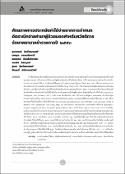บทคัดย่อ
ค่าใช้จ่ายด้านยาสำหรับผู้ป่วยนอกในระบบจ่ายตรงของสวัสดิการรักษาพยาบาลข้าราชการยังคงสูงอย่างต่อเนื่องในปี 2552-2553 เนื่องจากการใช้ยานอกบัญชียาหลักแห่งชาติในสัดส่วนที่มาก แม้โรงพยาบาลหลายแห่งจะมีการดำเนินมาตรการควบคุมค่าใช้จ่าย การศึกษาใช้ข้อมูลจากโรงพยาบาลของรัฐขนาดใหญ่ 28 แห่ง เพื่อประมาณการความประหยัดจากการกำหนดอัตราเบิกจ่ายค่ายาภายใต้เงื่อนไข 2 ประการ คือ ใช้ราคาของยาในบัญชียาหลักแห่งชาติในกลุ่มเดียวกัน และใช้ราคาอ้างอิงจากยาที่มีตัวยาสำคัญเดียวกันและรูปแบบเดียวกัน พบว่า หากกำหนดเงื่อนไขการเบิกจ่ายที่ค่อนข้างเข้มงวดในอัตราต่อใบสั่งที่อ้างอิงกับราคาต่ำสุดของยาในบัญชียาหลักฯ ที่อยู่กลุ่มเดียวกัน คือมีรหัส Anatomical, Therapeutic, and Chemical (ATC) ระดับ 1-3 ที่เหมือนกัน (เช่น ใช้ราคายาสามัญของ simvastatin สำหรับยากลุ่มควบคุมไขมันในเลือด) พบว่า จะสามารถลดค่าใช้จ่ายในปี 2553 ของกลุ่มยาที่ใช้มากและมีค่าใช้จ่ายสูง 3 กลุ่ม ได้แก่ ยาควบคุมไขมันในเลือด ยาต้านข้ออักเสบ (non-steroidal anti-inflammatory drug (NSAID), cyclo-oxygenase (COX-2) inhibitor, และ symptomatic slow-acting drugs for osteoarthritis (SYSADOA)) และยาลดการหลั่งกรด (histamine-2 receptor antagonist (H-2RA) และ proton pump inhibitor (PPI)) ลงได้ ร้อยละ 72.8, 85.7 และ 86.5 ตามลำดับ แต่ถ้ากำหนดเงื่อนไขการเบิกจ่ายตามจริงของแต่ละโรงพยาบาลแต่ไม่เกินเพดานซึ่งอ้างอิงกับค่ามัธยฐานของอัตราต่อใบสั่งตามรหัส ATC 1-5 ของยาเดียวกัน จะสามารถประหยัดค่าใช้จ่ายของยาควบคุมไขมันในเลือดและยาต้านข้ออักเสบได้ ร้อยละ 13.4 และร้อยละ 13.3 ตามลำดับ สำหรับยา 20 กลุ่มที่มีค่าใช้จ่ายสูง เงื่อนไขการเบิกจ่ายดังกล่าวช่วยประหยัดค่าใช้จ่ายได้ร้อยละ 14.0 ของค่าใช้จ่ายรวมสำหรับยาทั้ง 20 กลุ่ม และถ้ากำหนดเงื่อนไขซึ่งมีความเข้มงวดที่ต่ำกว่า โดยใช้อัตราคงที่เท่ากันทุกโรงพยาบาลซึ่งอ้างอิงกับค่ามัธยฐานของอัตราต่อใบสั่งตามรหัส ATC 1-5 เช่นกัน จะประหยัดค่าใช้จ่ายได้ร้อยละ 2.9 ของค่าใช้จ่ายสำหรับยาทั้ง 20 กลุ่ม ดังนั้น กรณีเลือกใช้มาตรการราคาอ้างอิงสำหรับควบคุมการใช้ยาที่มีค่าใช้จ่ายสูง โดยเลือกค่ามัธยฐานของอัตราต่อใบสั่งตามยาที่มีรหัส ATC 1-5 เหมือนกัน และอยู่ในรูปแบบเดียวกัน เป็นราคาอ้างอิงอัตราคงที่เท่ากันทุกโรงพยาบาล จะเป็นทางเลือกที่ควบคุมค่าใช้จ่ายได้น้อยที่สุด
บทคัดย่อ
The medical expenditure for outpatients under the Civil Servant Medical Benefit Scheme’s direct
billing system continued to be very high in 2009-2010 due to the use of drugs outside the National Lists of
Essential Medicines. This study estimated potential cost-savings using the aggregate drug utilization data
from 28 large public hospitals under two scenarios of reimbursement: 1) the lowest price of generic in each
drug group, and 2) median price of each drug. If the reimbursement rate was set most restrictively based
on the minimum price of the essential drug with an equivalent Anatomical, Therapeutic, and Chemical
(ATC) code 1-3 (eg. the lowest price of simvastatin for antilipids), the expenditure for antilipids,
antiosteoarthritis (non-steroidal anti-inflammatory drug (NSAID), cyclo-oxygenase (COX-2) inhibitor, and
symptomatic slow-acting drugs for osteoarthritis (SYSADOA)), and antisecretory/antiulcers (histamine-
2 receptor antagonist (H-2RA) and proton pump inhibitor (PPI)) in 2010 would be reduced by 72.8, 85.7,
and 86.5%, respectively. If each individual hospital was allowed the drug reimbursement as is but no
higher than a ceiling determined as the median of price per prescription for the drug with the equivalent
ATC 1-5, the expenditure for antilipids and antiosteoarthritis would be reduced by 13.4 and 13.3%, respectively.
For 20 drug groups with relatively high expenditure, the reimbursement ceiling could reduce the
expenditure by 14.0%. The least restrictive reimbursement condition using a fixed rate referent to the
median price of drugs with equivalent ATC 1-5 from all hospitals could reduce the expenditure for the 20
drug groups by 2.9%. Therefore, to contain expenditure using a fixed rate of reference price based on
drugs with an equivalent ATC 1-5 would be the least restrictive policy option.


